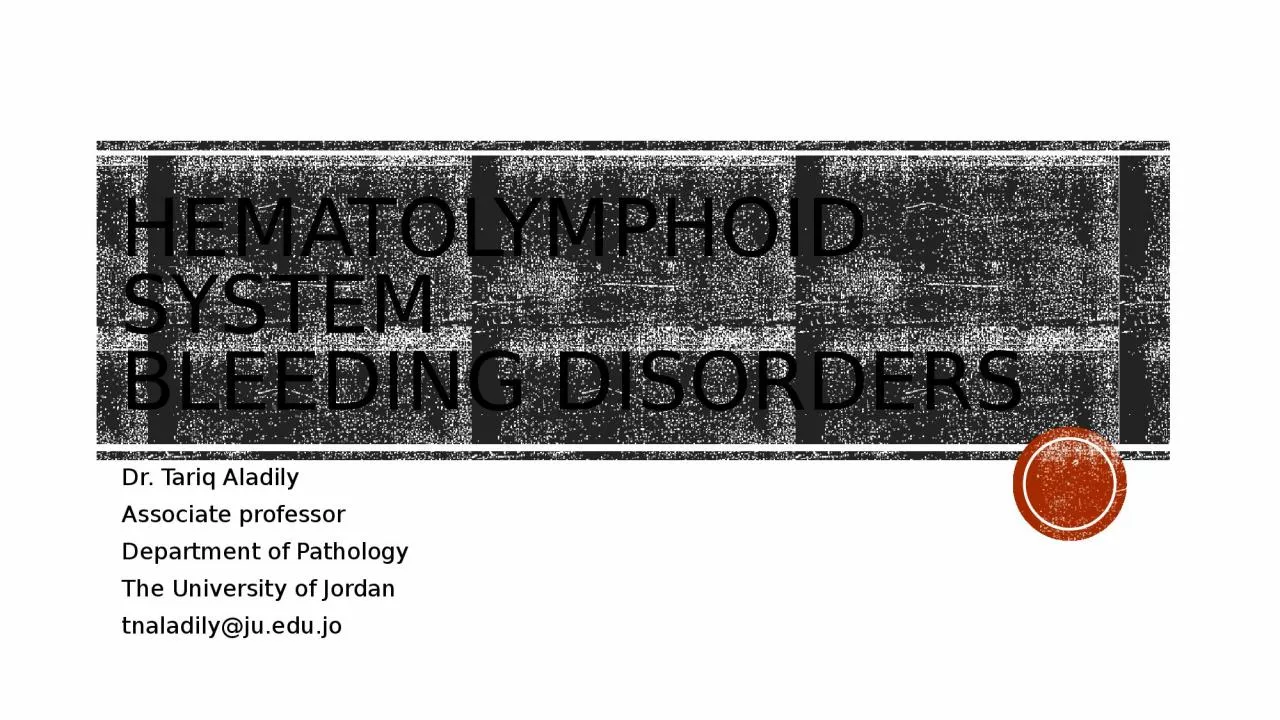

Dr Tariq Aladily Associate professor Department of Pathology The University of Jordan tnaladilyjuedujo Abnormal bleeding Defined as spontaneous bleeding or prolonged bleeding after trauma Caused by abnormality in ID: 1033021
Download Presentation The PPT/PDF document "Hematolymphoid system bleeding disorders" is the property of its rightful owner. Permission is granted to download and print the materials on this web site for personal, non-commercial use only, and to display it on your personal computer provided you do not modify the materials and that you retain all copyright notices contained in the materials. By downloading content from our website, you accept the terms of this agreement.
1. Hematolymphoid systembleeding disordersDr. Tariq AladilyAssociate professorDepartment of PathologyThe University of Jordantnaladily@ju.edu.jo
2. Abnormal bleedingDefined as spontaneous bleeding or prolonged bleeding after traumaCaused by abnormality in:1) platelets2) clotting factors3) blood vessels – endothelial cells
3. Fragile Blood vesselsHigh corticosteroid Scurvy (vitamin C deficiency)Vasculitis (autoimmune or infectious)Inherited disorders of connective tissuePatients develop spontaneous petechiae and ecchymoses in skin and mucous membranesLaboratory tests of platelets and clotting factors are normal
4. Disseminated intravascular coagulation (DIC)Systemic activation of coagulation system in the bodyFormation of myriads of thrombi in the microcirculation, may cause ischemia and microinfarctionFollowed by activation of fibrinolysisThen patients become at risk of severe bleeding (consumed platelets and clotting factors)Patients develop thrombocytopenia, anemia and schistocytes
5. Pathogenesis1) Release of tissue factor into the circulation (activates extrinsic pathway)2) Widespread endothelial damage (causes release of tissue factor and expose the subendothelial von Willebrand factor)3) Release of negatively charged substances in the circulation (activates intrinsic pathway)
6. High Tissue factor releaseFrom placenta, in obstetric complicationsFrom certain cancer cells (acute promyelocytic leukemia, adenocarcinoma)Bacterial sepsis, bacterial toxins activate TF on monocytes, also monocytes secrete tumor necrosis factor and IL-1 that stimulate expression of TF on endothelium and inhibit thrombomodulin
7. Widespread endothelial damageDeposition of antigen-antibody complexes (systemic lupus erythematosus, vasculitis)Severe heat exposure (heat stroke, burn injury)Snake venomCertain infections (meningococci, rickettsiae, COVID19), this condition is called systemic inflammatory response syndrome
8. Activation of intrinsic pathwayMassive tissue damage (trauma, surgery)Head injuryBrain substance and collagen are negatively charged particles that are released in blood
9. Clinical and laboratory findingsThrombocytopenia, prolonged PT and PTT, schistocytesAcute DIC (e.g. obstetric complication) shows ecchymosis, severe hemorrhage into body cavitiesChronic DIC (e.g. cancer related) shows recurrent thrombosis-----------Waterhouse-Friderichsen syndrome: meningococcous sepsis DIC adrenal hemorrhage acute adrenal failure (no steroids, hypotension)Sheehan syndrome: complicated labor DIC severe hemorrhage pituitary ischemia and necrosis
10. Thrombotic thrombocytopenic purpura (TTP) & hemolytic uremic syndrome (HUS)Widespread formation of platelets-rich thrombi in microcirculationNO activation of clotting factors (normal PT and PTT)Leads to thrombocytopenia and tendency for bleedingClinically: fever, thrombocytopenia, microangiopathic hemolytic anemia, renal failure and neurologic symptoms (the latter not present in HUS)
11. TTPCongenital or acquiredDeficiency in metalloproteinase ADAMTS13, normally negatively control vWFADAMTS13 normally cleaves the precursor of vWF (large multimer molecule) into vWF. This multimer is capable of binding multiple platelets causing thrombosis
12. HUSCaused by E. Coli O157:H7 bacterial infectionFood borneBacteria secretes toxin that activates complement system and causes endothelial damage, mainly in kidneys
13. Von Willibrand factorEndothelial cells are normally the major source of vWFIt is also present in platelets granules and subendothelial areaFacilitate platelets adhesion to damaged blood vesselsIt also stabilizes factor VIIIPrecursor of vWF is a large multimer moleculeExamined by ristocetin aggregation test (ristocetin enhances vWF binding to platelets), if no aggregation vWF deficiency
14. Von willibrand diseaseAutosomal dominantMost common inherited bleeding disorder (1% of population in US)Affects platelets function (dominant symptom) and coagulation (factor VIII)Patients present with ecchymosis, easy bleeding and menorrhagiaIn homozygous disease, factor VIII deficiency becomes severe enough to resemble hemophilia A diseaseType 1: most common, modest reduction of vWF levelType 2A: the precursor of vWF is not synthesized, tooType 2B: the precursor of vWF is unstable with very short half-life, capable of binding to multiple platelets causing thrombocytopenia as well
15. Hemophilia AX-linked diseaseMost common cause of inherited serious bleedingDeficiency in factor VIII (prolonged PTT)70% have a family history, 30% appears as a new mutationSevere disease occurs when the level of factor VIII drops to 1% of normal level (spontaneous bleeding)Mild deficiency: bleeding occurs after trauma or surgeryIn 10% of patients: normal level but abnormal functionBleeding occurs in body cavities (joints, abdomen, chest), no petechiaeHemophilia B: identical to hemophilia A, less common, factor IX deficiency
16. ThrombocytopeniaDefined as platelets count below 150,000 cell/uLIncreased risk of bleeding occurs when count drops below 50,000Spontaneous bleeding: <5,000Bleeding occurs in superficial parts of body (skin, mucous membranes), called petechiae and ecchymosisLarger hemorrhage occurs in brainThrombocytopenia may occur in the setting of increased platelets destruction (bone marrow shows increased megakaryocytic activity) or decreased production from bone marrowHIV infection causes thrombocytopenia (both increased destruction and decreased megakaryocytic survival)
17. Immune thrombocytopenic purpuraAcute ITP is seen in children after viral infection (self-limited)Chronic ITP is commonly seen in middle-age womenFormation of autoantibody (IgG) against glycoprotein Iib/IIIa or Ib/IX complexes Splenic histiocytes remove coated platelets and destroy themSplenomegaly is NOT prominent, but patients benefit from splenectomyBone marrow shows proliferating megakaryocytes
18. Heparin-induced thrombocytopeniaModerate to severe thrombocytopenia affects 5% of patients receiving heparin after 1-2 weeks of therapyFormation of IgG antibody that binds factor-4 in a heparin-dependent manner, resulting in platelets activation and thrombosis (consumptive thrombocytopenia)Mostly seen in high-molecular weight heparin